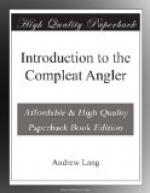In making rods, Walton is most concerned with painting them; ’I think a good top is worth preserving, or I had not taken care to keep a top above twenty years.’ Cotton prefers rods ‘made in Yorkshire,’ having advanced from the home-made stage. His were spliced, and kept up all through the season, as he had his water at his own door, while Walton trudged to the Lee and other streams near London, when he was not fishing the Itchen, or Shawford Brook. The Angler’s Vade Mecum recommends eighteen-feet rods: preferring a fir butt, fashioned by the arrow-maker, a hazel top, and a tip of whalebone. This authority, even more than Walton, deals in mysterious ‘Oyntments’ of gum ivy, horse-leek, asafoetida, man’s fat, cat’s fat, powdered skulls, and grave earth. A ghoulish body is the angler of the Vade Mecum. He recommends up-stream fishing, with worm, in a clear water, and so is a predecessor of Mr. Stewart. ’When you have hooked a good fish, have an especial care to keep the rod bent, lest he run to the end of the line’ (he means, as does Walton, lest he pull the rod horizontal) ‘and break either hook or hold.’ An old owner of my copy adds, in manuscript, ’And hale him not to near ye top of the water, lest in flaskering he break ye line.’
This is a favourite device of sea trout, which are very apt to ‘flasker’ on the top of the water. The Vade Mecum, in advance of Walton on this point, recommends a swivel in minnow-fishing: but has no idea of an artificial minnow of silk. I have known an ingenious lady who, when the bodies of her phantom minnows gave out, in Norway, supplied their place successfully with bed-quilting artfully sewn. In fact, anything bright and spinning will allure fish, though in the upper Ettrick, where large trout exist, they will take the natural, but perhaps never the phantom or angel minnow. I once tried a spinning Alexandra fly over some large pond trout. They followed it eagerly, but never took hold, on the first day; afterwards they would not look at it at all. The Vade Mecum man, like Dr. Hamilton, recommends a light fly for a light day, a dark fly for a dark day and dark weather; others hold the converse opinion. Every one agrees that the smallness of the flies should be in proportion to the lowness of the water and the advance of summer. {7}
Our ancestors, apparently, used only one fly at a time; in rapid rivers, with wet fly, two, three, or, in lochs like Loch Leven, even four are employed. To my mind more than two only cause entanglements of the tackle. The old English anglers knew, of course, little or nothing of loch fishing, using bait in lakes. The great length of their rods made reels less necessary, and they do not seem to have waded much. A modern angler, casting upwards, from the middle of the stream, with a nine-foot rod, would have astonished Walton. They dealt with trout less educated than ours, and tooled with much coarser and heavier implements. They had no




